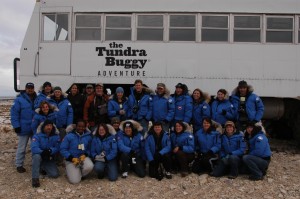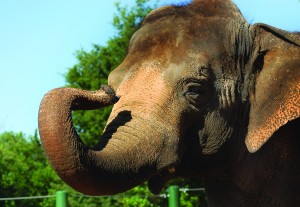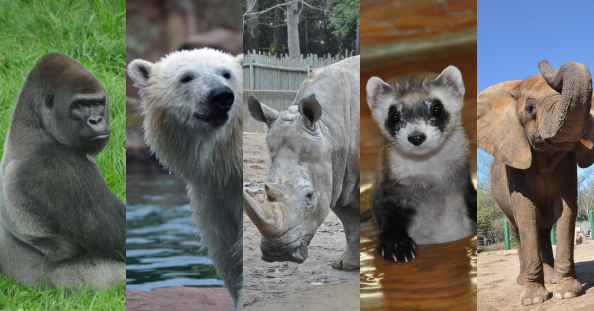The eastern cougar, the western black rhinoceros, the Japanese river otter, the Formosan clouded leopard: these are just a few among the thousands of species that have been declared extinct within the last five years. Our world is entrenched in an extinction crisis. The repercussions are still uncertain but the solution is clear: We must work together now to deter and abate this crisis.
The Louisville Zoo has always dedicated itself to bettering the bond between people and our planet. Educating visitors on habitat conservation, encouraging ways to live in better balance with our planet, and inspiring care and concern for wildlife through amazing animal encounters is at the heart of our mission.
We are also working hard behind the scenes to assist conservation efforts, both through research at the Zoo and conservation efforts in the field. We actively participate and excel in the Black-Footed Ferret Recovery Program. Headed by Keeper Guy Graves, the ferrets once thought extinct are now being repopulated due to this program’s success. “We have produced over 1,000 BFF kits since 1991, with over 700 going for release,” said Graves. “We are currently in this year’s breeding season with our first litter due the end of May. The kits that are born this spring will be released into managed wild environments in the fall at about three months of age.”

Angela Johnson (front row – third from right) in Churchil
Many of our staff members have visited Churchill Canada to work with Polar Bears International (PBI) to learn more about climate change issues and see the effects on the native wildlife firsthand. Keepers Angela Johnson, Hunter Veeneman and Educator Kathleen Johnson are just three of our staff who have attended International Leadership Camps with PBI and returned to actively support and create programs to assist in the climate change crisis.
Hunter approached the Youth Board about fundraising for a new bike rack to quadruple bike parking for the Zoo in efforts to reduce carbon emissions and secured their support. He also participates in “Cycle for Change” — a public awareness campaign to inspire communities to bicycle commute — and “Bike Commute Challenge.” Last year, with other Zoos across the country, Hunter and Louisville Zoo team members Patrick Gage, Tracy Parke, Matt Lahm and Dan Cole put away their car keys and biked in a nationwide effort to reduce carbon emissions. Your Louisville Zoo participants logged 899.7 miles commuting to and from work in the month of September alone! All of the participants together eliminated over 6,000 lbs. of CO2 emissions on behalf of Polar Bear Conservation.
Angela Johnson and her PBI zoo keeper group created the Acres for the Atmosphere (AFTA) program, the focus of which is to increase green spaces on large tracts of land, not only through planting trees but also by saving existing forests, parks and plots of land. “For every acre that is planted, we have the potential to slow the Arctic ice melt and ensure future generations can appreciate polar bears in their natural habitat,” said Johnson. Members work to develop outside partnerships engaging in the reduction of carbon emissions through energy conservation practices, recycling and stewardship. Angela also worked with Kathleen Johnson, who created a series of polar bear education programs. Due to AFTA, the Louisville Zoo receives a yearly LG&E grant (Eon) that allows our horticulture department money to purchase and plant new trees.
Along with our own conservation efforts at the Louisville Zoo, The Association of Zoos and Aquariums (AZA) is building on existing animal conservation efforts with AZA SAFE: Saving Animals from Extinction, a new commitment by the 229 accredited zoos and aquariums to work together to target specific endangered species and save them from extinction by restoring healthy populations in the wild.
Aquarium and zoo leadership have identified more than 100 species facing the greatest threats — and where zoos and aquariums have unique conservation and science knowledge to contribute to saving these species.
Starting in 2015, AZA SAFE will focus on 10 species and then add an additional 10 species each year for at least the next decade. The first 10 species are: African penguin, Asian elephant, black rhinoceros, cheetah, gorilla (western lowland), vaquita (a critically endangered porpoise species), sharks, western pond turtle and the whooping crane.
 Two of the first 10 species you can find here at the Louisville Zoo: the Asian elephant and the western lowland gorilla.
Two of the first 10 species you can find here at the Louisville Zoo: the Asian elephant and the western lowland gorilla.
AZA-accredited zoos and aquariums have already prevented the extinction of more than 30 species. These species would have ceased to exist if not for the dedication of the staff within AZA-accredited facilities, working tirelessly to ensure that these species live on. We can work to ensure more species are protected.
When you visit the Louisville Zoo, purchasing admission or membership, you automatically support conservation action both in the field and behind the scenes here at the Zoo. Without aid, there may come a time when the remaining wild will cease to exist and much of our precious wildlife with it. Let’s all work to understand and protect wildlife now before it’s too late.

